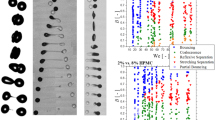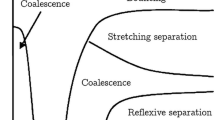Abstract.
An experimental investigation of viscous binary droplet collisions in a vacuum environment is conducted. The fundamental ramifications of conducting such experiments in a vacuum environment are twofold. The first, which is the motivating factor of this work, assures that the collision products are unimpeded by aerodynamic effects which tend to disrupt the collision process at a much earlier stage in the processes than if they were absent, and second, the phenomenon of encapsulation of the host medium between the colliding droplets is not present in this study; a fact that limits the scope of direct application of this study to a number of (but not all) applications. Droplets are generated from capillary stream breakup with the imposition of an amplitude-modulated disturbance which results in the generation of highly uniform pre-collision drops at separations far extending those which are possible from a standard (monochromatic) sinusoidal disturbance. Hence, the collision products are able to deform unimpeded by interactions with neighboring collision products. Measurements over a broad range of Weber number, We, indicate that the value of the critical Weber number, We c, is more than 100 times greater for the 30-cSt fluid than the corresponding value for similarly sized water drops in a standard ambient environment. Measurements of the oblate and prolate half-cycle oscillation periods resulting from the binary collision reveal a distinct behavior that is observed and documented here for the first time. Additionally, measurements of the radial extent of the deformed mass at the instant of maximum deformation have been conducted and allow quantification of the energy dissipation. These measurements show that the energy dissipation increases with increasing fluid viscosity, which contradicts the results published by others.
Similar content being viewed by others
Author information
Authors and Affiliations
Additional information
Electronic Publication
Rights and permissions
About this article
Cite this article
Willis, .K., Orme, .M. Binary droplet collisions in a vacuum environment: an experimental investigation of the role of viscosity. Exp Fluids 34, 28–41 (2003). https://doi.org/10.1007/s00348-002-0526-4
Received:
Accepted:
Issue Date:
DOI: https://doi.org/10.1007/s00348-002-0526-4




